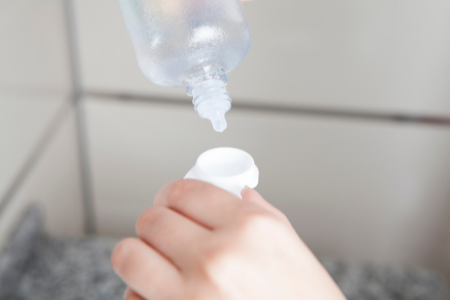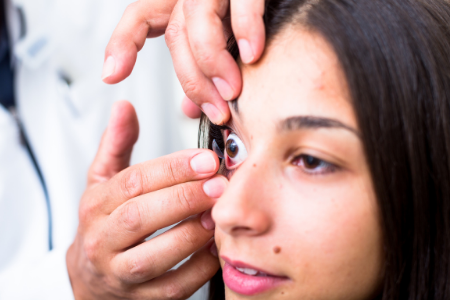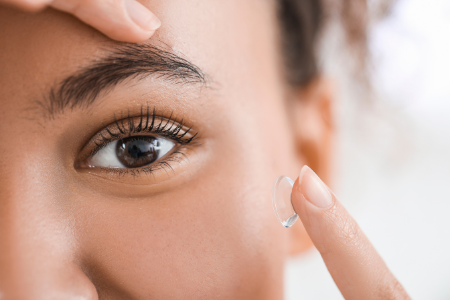What do contacts do for my eyes?
- What are the types of contacts today?
- How can I pick the right contacts for my eyes?
- What’s it like to be fitted for contacts?
Contact lenses have come a long way since the first version of the gas permeable (GP) lens was created in 1948. Now we have bifocal contacts, disposable contacts, colored contacts, and more. If you struggle with your vision, contacts remain a great option if you want to correct your eyesight without wearing glasses.
However, if you’re considering contacts, you have some choices to make. There are many contact options out there—how will you find the one that’s right for you? We have answers that will help you select the best vision correction for your goals, situation, and health.
What Do Contacts Do for My Eyes?
Contact lenses are assisted medical devices that you wear on the outside (cornea) of the eye. A contact lens is a thin, curving, hard or soft clear lens that rides on the eye’s surface. Contact lenses work just like glasses by correcting refractive errors that blur your vision.
Light comes in at the front of the eye. Refraction, or the bending of the light, occurs as the ray moves toward the back of the eye’s optic nerve. For you to have perfect vision, the light must bend properly to hit the optic nerve in just the right place to transmit a crystal-clear image of what you see to the brain. More than 150 million Americans, however, suffer from a refractive error, where that light isn’t bent properly at all.
The symptom of a refractive error is usually blurry vision, but you may also experience:
- Double vision
- Eyestrain
- Headaches
- Problems reading or looking at a computer or your phone
- Seeing halos around bright lights
There are four types of common refractive errors:
- Myopia, or nearsightedness, which makes distant objects blurry
- Hyperopia, or farsightedness, that blurs objects close to you
- Astigmatism, which is a combination of both of these conditions
- Presbyopia, is an age-related condition that makes near items blurry
Refractive errors can be caused by the shape of the cornea or your eyeball length or even the natural aging of the clear lens at the front of your eye.
No matter the cause, when you suffer from these eye conditions, it’s common to seek out prescription lenses to correct how the light hits your eye. Depending on your vision issue, glasses or contacts may help.
What Are the Types of Contacts Today?

Hard contacts were the early version of contacts. They’re technically called rigid gas permeable (RGP) lenses and offer clear, crisp vision. Hard contacts are long wearing and usually not disposable. Because they last longer than soft contacts, they are less expensive over time. RGP lenses also are less likely to tear. However, they are not as comfortable as soft contacts.
Soft contacts were the next iteration of the old RGP lenses. They’re made of flexible plastics that let oxygen pass through the lens to your cornea. Generally, soft contacts are more comfortable than RGP lenses, which can be particularly appealing to the new lens wearer.
Within these categories of contacts, there are a few characteristics based on the type of eye wear you choose. For example, you can talk with your doctor about:
- Extended wear contacts, which can be worn at night and you also wear them for up to 30-days potentially
- Disposable contacts that are soft and can be used once then thrown away
- Specialized decorative contacts for the theater, cosmetic appeal, and more—colored contacts fall into this category
No matter the type of contact lenses you choose, the one thing you must be certain of is that you work closely with your eye doctor to select the right contacts for your eyes.
How Can I Pick the Right Contacts for My Eyes?
Talk with your eye doctor about the right contacts for your particular diagnosis and situation. There are several kinds of contacts to choose from, so before choosing the type of contact lens you want, consider, first how long you’ll want to wear them? Here are some good questions to consider:
- Do you want a disposable lens that you change out daily?
- Would you rather have contacts that you wear for a week or longer?
- How about wearing your contacts overnight, if that’s an option for you?
- Do you have specific eye issues to consider, such as dry eyes or allergies?
- Would you like a colored lens?
- Do you wear bifocals?
Your doctor can talk with you about whether rigid or soft contacts are the right choice for you. (Typically, soft contacts are the preferred choice.) There are also cost considerations and your budget to consider. Some brand names are higher priced and the lens type, length of wear and any dramatic effects you opt for may be more expensive.
It’s important to pick the right kind of contact lenses for your eyes. Why? For example, if you wear the daily disposable lenses as extended wear, you can damage your cornea. The same is true if you try to wear an RGP lens overnight. Also, contacts may not even be the best choice for eye correction if you are subject to eye infections or work at a company where it is very dusty and dirty.
Your doctor will walk you through all of the choices to consider. There’s a process to be fitted for contacts. Here’s what it’s like.
What’s It Like to Be Fitted for Contacts?

If you’ve been approved for contacts, and you have your prescription in hand, your doctor will help you select the right type of lens that fits your lifestyle. Once you’ve made your selection, the doctor will send away an order for your contacts to be made. When they’ve arrived back, you will return to the doctor’s office to be fitted. The fitting process includes:
- Education on how to safely insert and remote the contacts
- Information on how to keep your contacts clean and your eyes healthy
- A walkthrough from your doctor about inserting contact lenses
- Some practice sessions of inserting and removing the lenses
It may take a few days to get used to the contacts and you should call your doctor if you are uncomfortable with wearing them after that time.
There’s a lot of freedom that comes with wearing contacts. However, there are risks and you must be careful to pick the contacts that are right for you. That’s where South Florida Eyecare Centers can help. Contact us to talk about your contacts with a board-certified optometrist today.


 What do contacts do for my eyes?
What do contacts do for my eyes?